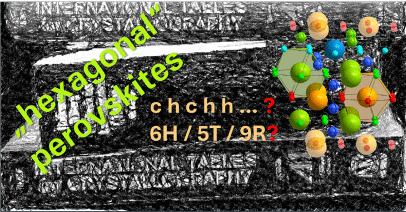当前位置:
X-MOL 学术
›
Chem. Mater.
›
论文详情
Our official English website, www.x-mol.net, welcomes your
feedback! (Note: you will need to create a separate account there.)
“Hexagonal” Perovskites: From Stacking Sequence to Space Group Symmetry and New Opportunities
Chemistry of Materials ( IF 7.2 ) Pub Date : 2024-09-18 , DOI: 10.1021/acs.chemmater.4c01789 Sylvia L. Kunz 1 , Michael Haefner 2 , Oliver Clemens 1
Chemistry of Materials ( IF 7.2 ) Pub Date : 2024-09-18 , DOI: 10.1021/acs.chemmater.4c01789 Sylvia L. Kunz 1 , Michael Haefner 2 , Oliver Clemens 1
Affiliation

|
The term “hexagonal perovskite” has been widely used in literature to discuss the structure of perovskite-type compounds with composition ABX3–y with partial h-type stacking of AX3 layers. Though the local surrounding of these AX3 layers resembles a hexagonal close packing, the space group symmetries reported for some of these materials are not belonging to the hexagonal crystal system but are trigonal or orthorhombic instead. Though reports and books with lists of hexagonal perovskites exist which assign stacking sequences and list a corresponding space group, a concise guideline on how the maximum symmetry of the perovskite type material is related to the stacking sequence has not been reported. Clearly, such a systematization of space group symmetry and stacking notations would be desirable; for distortion or ordering variants of the cubic perovskite, the whole research community benefits from concepts of group-subgroup relations or classification of tilting via the Glazer notation. In this article, we derive a fully consistent guideline on how the aristotype space group symmetry can be determined for any stacking sequence (e.g., cchhchcch, ...) in the Jagodzinski notation and provide a computer program which can do this analysis. By this, one can narrow down the possible aristotype space group symmetries for any perovskite stacking sequence with h-type layers to seven space groups in total (R3̅m, P3̅m, P63/mmc, P6̅m2, R3m, P3m, and P63mc). The space groups can be directly derived from the Jagodzinski sequence. Remarkably, the possibility to obtain polar perovskites with h-type layers by stacking has not been recognized in literature so far and provides the opportunity to develop new multiferroic materials by design of stacking.
中文翻译:

“六方”钙钛矿:从堆叠顺序到空间群对称性和新机遇
“六方钙钛矿”一词在文献中广泛用于讨论成分为ABX 3– y且具有AX 3层的部分h型堆叠的钙钛矿型化合物的结构。尽管这些AX 3层的局部周围类似于六方密堆积,但其中一些材料报告的空间群对称性不属于六方晶系,而是三角形或斜方晶系。尽管存在列出六方钙钛矿列表的报告和书籍,其中指定了堆叠顺序并列出了相应的空间群,但尚未报道关于钙钛矿型材料的最大对称性如何与堆叠顺序相关的简明指南。显然,这种空间群对称性和堆叠符号的系统化是值得期待的。对于立方钙钛矿的畸变或有序变体,整个研究界受益于通过格雷泽符号进行的群-子群关系或倾斜分类的概念。在本文中,我们得出了关于如何确定 Jagodzinski 符号中的任何堆叠序列(例如cchhchcch ,...)的亚里斯多型空间群对称性的完全一致的指南,并提供了可以进行此分析的计算机程序。 通过这种方式,可以将任何具有h型层的钙钛矿堆叠序列的可能的亚里斯多型空间群对称性缩小到总共七个空间群( R 3̅ m , P 3̅ m , P 6 3 / mmc , P 6̅ m 2, R 3 m 、 P 3 m和P 6 3 mc )。空间群可以直接从 Jagodzinski 序列导出。值得注意的是,迄今为止,通过堆叠获得具有h型层的极性钙钛矿的可能性尚未在文献中得到认可,这为通过堆叠设计开发新型多铁性材料提供了机会。
更新日期:2024-09-20
中文翻译:

“六方”钙钛矿:从堆叠顺序到空间群对称性和新机遇
“六方钙钛矿”一词在文献中广泛用于讨论成分为ABX 3– y且具有AX 3层的部分h型堆叠的钙钛矿型化合物的结构。尽管这些AX 3层的局部周围类似于六方密堆积,但其中一些材料报告的空间群对称性不属于六方晶系,而是三角形或斜方晶系。尽管存在列出六方钙钛矿列表的报告和书籍,其中指定了堆叠顺序并列出了相应的空间群,但尚未报道关于钙钛矿型材料的最大对称性如何与堆叠顺序相关的简明指南。显然,这种空间群对称性和堆叠符号的系统化是值得期待的。对于立方钙钛矿的畸变或有序变体,整个研究界受益于通过格雷泽符号进行的群-子群关系或倾斜分类的概念。在本文中,我们得出了关于如何确定 Jagodzinski 符号中的任何堆叠序列(例如cchhchcch ,...)的亚里斯多型空间群对称性的完全一致的指南,并提供了可以进行此分析的计算机程序。 通过这种方式,可以将任何具有h型层的钙钛矿堆叠序列的可能的亚里斯多型空间群对称性缩小到总共七个空间群( R 3̅ m , P 3̅ m , P 6 3 / mmc , P 6̅ m 2, R 3 m 、 P 3 m和P 6 3 mc )。空间群可以直接从 Jagodzinski 序列导出。值得注意的是,迄今为止,通过堆叠获得具有h型层的极性钙钛矿的可能性尚未在文献中得到认可,这为通过堆叠设计开发新型多铁性材料提供了机会。











































 京公网安备 11010802027423号
京公网安备 11010802027423号